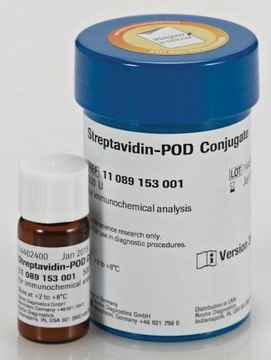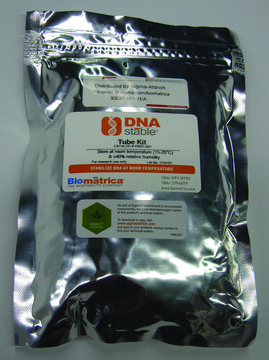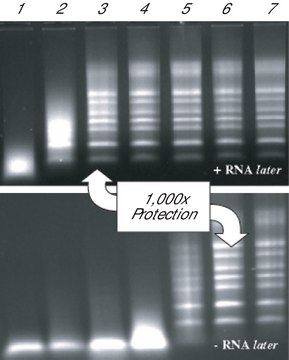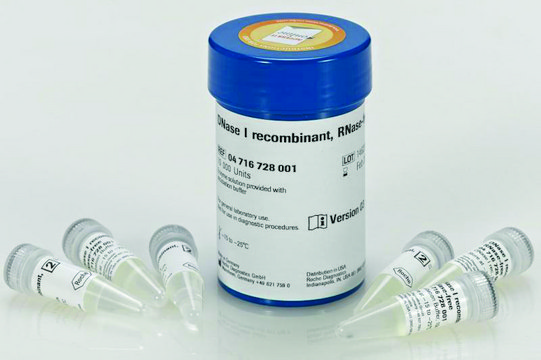11112481001
Roche
Streptavidin-β-Gal conjugate
lyophilized (clear, colorless solution after reconstitution), pkg of 500 U
Sign Into View Organizational & Contract Pricing
All Photos(1)
Synonym(s):
streptavidin
UNSPSC Code:
12352200
Recommended Products
form
lyophilized (clear, colorless solution after reconstitution)
packaging
pkg of 500 U
manufacturer/tradename
Roche
storage temp.
−20°C
General description
Streptavidin is covalently coupled to β-galactosidase from E. coli.
Application
- Use Streptavidin-β-Gal to detect biotinylated compounds using: ELISA
- Immunohistocytochemistry
- Western blot
- In situ hybidization
Preparation Note
Working concentration: Working concentration of conjugate depends on application and substrate. The following concentrations should be taken as a guideline:
Storage conditions (working solution): The reconstituted solution is stable at 2 to 8 °C for four weeks. Aliquots should be stored at -15 to -25 °C.
Note: Avoid repeated freezing and thawing.
- ELISA: 100 to 500 mU/ml
- Immunohistocytochemistry: 250 to 500 mU/ml
- Western blot: 250 to 500 mU/ml
Storage conditions (working solution): The reconstituted solution is stable at 2 to 8 °C for four weeks. Aliquots should be stored at -15 to -25 °C.
Note: Avoid repeated freezing and thawing.
Reconstitution
Add 1 ml double-distilled water to a final concentration of 500 U/ml.
Other Notes
For life science research only. Not for use in diagnostic procedures.
related product
Product No.
Description
Pricing
Signal Word
Warning
Hazard Statements
Precautionary Statements
Hazard Classifications
Aquatic Chronic 3 - Skin Sens. 1
WGK
WGK 2
Flash Point(F)
does not flash
Flash Point(C)
does not flash
Regulatory Information
常规特殊物品
Certificates of Analysis (COA)
Search for Certificates of Analysis (COA) by entering the products Lot/Batch Number. Lot and Batch Numbers can be found on a product’s label following the words ‘Lot’ or ‘Batch’.
Already Own This Product?
Find documentation for the products that you have recently purchased in the Document Library.
Ramona Trebbien et al.
Virology journal, 8, 434-434 (2011-09-10)
Pigs are considered susceptible to influenza A virus infections from different host origins because earlier studies have shown that they have receptors for both avian (sialic acid-alpha-2,3-terminal saccharides (SA-alpha-2,3)) and swine/human (SA-alpha-2,6) influenza viruses in the upper respiratory tract. Furthermore
Monica Ronco et al.
Developmental biology, 313(1), 80-92 (2007-12-07)
Our understanding of the developmental mechanisms underlying the vast diversity of arthropod appendages largely rests on the peculiar case of the dipteran Drosophila melanogaster. In this insect, homothorax (hth) and extradenticle (exd) together play a pivotal role in appendage patterning
Our team of scientists has experience in all areas of research including Life Science, Material Science, Chemical Synthesis, Chromatography, Analytical and many others.
Contact Technical Service






